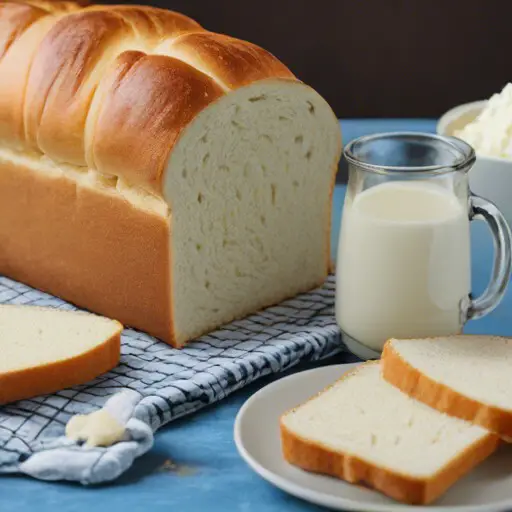Embark on a delightful journey into the world of baking mastery as we uncover the secrets behind creating the easiest and most moist Milk Bread. In this extensive exploration, we will demystify the art of bread-making, guiding you through a step-by-step process that guarantees a soft crumb and unparalleled moisture in every slice. Join us as we delve into the heart of this culinary masterpiece, where simplicity meets indulgence in a loaf that’s not only easy to make but also a testament to the joy of homemade goodness.
Ingredients:
- Bread Flour (4 cups): The foundation of our bread, providing structure and a soft, chewy texture.
- Whole Milk (1 cup): Contributing richness and ensuring a moist and tender crumb.
- Granulated Sugar (1/4 cup): Balancing sweetness and enhancing the overall flavor profile.
- Unsalted Butter (1/4 cup, softened): Infusing the bread with a buttery richness for added moisture.
- Active Dry Yeast (2 1/4 teaspoons or 1 packet): The leavening agent that gives our bread its rise.
- Salt (1 1/2 teaspoons): Enhancing the overall flavor and controlling the yeast’s activity.
- Egg (1 large, at room temperature): Providing structure and contributing to the bread’s richness.
Instructions:
- Activate the Yeast: In a small bowl, combine the active dry yeast with warm milk and a pinch of sugar. Allow it to sit for 5-10 minutes until it becomes frothy, indicating that the yeast is activated.
- Mix the Dough: In a large mixing bowl, combine the bread flour, sugar, softened butter, salt, beaten egg, and the activated yeast mixture. Mix until the ingredients form a cohesive dough.
- Knead the Dough: Turn the dough onto a floured surface and knead it for about 10 minutes or until it becomes smooth and elastic. Alternatively, use a stand mixer with a dough hook for ease.
- First Rise: Place the kneaded dough in a greased bowl, cover it with a damp cloth, and let it rise in a warm place for 1-2 hours or until it has doubled in size.
- Shape the Loaf: Punch down the risen dough, shape it into a loaf, and place it in a greased loaf pan. Cover it with a damp cloth for the second rise, allowing it to double in size again.
- Preheat and Bake: Preheat the oven to 350°F (175°C). Bake the bread for 25-30 minutes or until the top is golden brown, and the bottom sounds hollow when tapped.
- Cool and Slice: Allow the freshly baked bread to cool in the pan for 10 minutes before transferring it to a wire rack to cool completely. Slice and savor the moist perfection!
Cook Notes:
- Room Temperature Ingredients: Using room temperature milk, egg, and butter helps the dough rise consistently and promotes even mixing.
- Checking Doneness: Tap the bottom of the bread, and if it sounds hollow, it’s done. Additionally, an internal temperature of around 190°F (88°C) ensures thorough baking.
- Consistent Kneading: Achieving a smooth and elastic texture through consistent kneading is crucial for a tender crumb.
- Let It Rise: Allowing the dough sufficient time to rise ensures the development of flavor and a soft, moist texture.
Variations:
- Honey Glazed Top: Brush the top of the loaf with a honey glaze during the last 5 minutes of baking for a shiny finish and a hint of sweetness.
- Cinnamon Swirl Delight: Roll out the dough, spread a mixture of cinnamon and sugar, then roll it back up before placing it in the loaf pan. Enjoy the aroma and taste of a delightful cinnamon swirl.
- Raisin and Nut Enrichment: Add a cup of raisins and chopped nuts to the dough during the kneading process for a textured and flavorful variation.
Keto Version:
For those embracing a keto lifestyle, substitute almond flour for bread flour and use a low-carb sweetener instead of sugar. Opt for unsweetened almond milk and replace the remaining sugar with a keto-friendly sweetener.
Low-Carb Version:
Reduce the overall carb content by replacing part of the bread flour with almond flour or coconut flour. Opt for a low-carb sweetener, and use unsweetened almond milk for a lower carb alternative.
As we conclude this comprehensive exploration into the realm of the Easiest and Most Moist Milk Bread, envision the joy of slicing into a loaf that embodies the perfect blend of simplicity and indulgence. Whether you enjoy it fresh with butter, transform it into French toast, or use it to create the ultimate sandwich, the soft crumb and buttery richness of this bread will always shine through. Here’s to the joy of uncomplicated baking, the pleasure of a well-risen loaf, and the endless possibilities that come with mastering the art of milk bread. May your kitchen be filled with the aroma of freshly baked perfection—a testament to the timeless allure of homemade bread!



